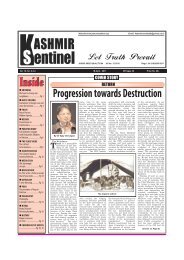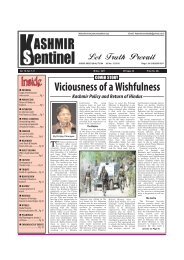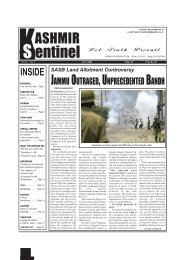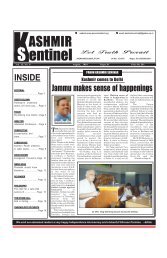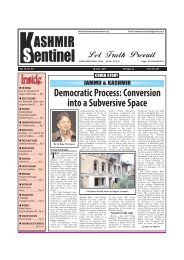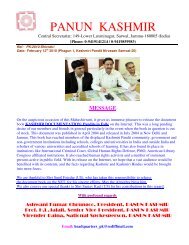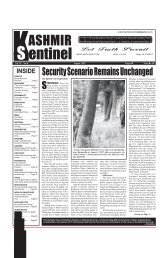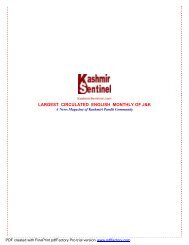You also want an ePaper? Increase the reach of your titles
YUMPU automatically turns print PDFs into web optimized ePapers that Google loves.
<strong>Kashmir</strong> Sentinel <strong>November</strong> 2002Shift to Rural Areas:<strong>Kashmir</strong> terrorist movement initially started as an urban insurgency. Two of the most disastrous results ofthis period of military muddle were that militancy was allowed to spread from urban to rural areas. Hadcorrection at the appropriate military level been taken to control the towns, known drills to isolate themfrom the countryside put into practice, it is more in than likely that the problem would have remainedconfined to a few towns and within certain specific areas inside them. The other fallout of bad planningat combat level and sloppy psychological efforts was delivery of neutral or uncommitted population tomilitants. Was Army leadership so naive as not to appreciate what was good for winning the war in<strong>Kashmir</strong>? “Suggestions on all these aspects were made and well in time. They were ignored due topersonal biases, lack of conviction and sheer lack of military acumen”, laments a former General.Pir Pantsal Control:By the time the Army leadership realised what had gone wrong it was too late. Pakistan had beguninducting battle-hardened mercenaries and gained direct control of all terrorist groups. Section, Flatoonand Battalion “commanders” were all Pakistanis. It was at this stage that it dawned on Army to dosomething.With induction of foreign mercenaries, there was better professionalism and quality of combat wasupgraded. To blunt the new strategies of the Army, terrorists decided to force dispersal of army byoccupying Pir Pantsal line in Doda, Rajouri and Udhampur districts. Terrorists’ objective was to dominateinhospitable terrain and gain automatic edge over the Valley by drawing Army to fight in this terrain.Army strategists did not appreciate it.Army had options to foil this design by denying the terrorists hideouts and gain control of this strategicregion. This was possible through sending long range patrols (which they are doing now), aerialreconnaissance and dominating the routes. One brigade strength of soldiers was enough to achieve thisobjective. With terrorists having dug deep, now even one division strength is insufficient to meet this task.Fallout of allowing terrorists to dominate Pir Pantsal region was something the political and military costof which was quite heavy. It forced dispersal of Army over a large and inhospitable area. Pakistan gainedpropaganda mileage that whole of J&K was up in arms. Srinagar-Jammu national highway becameinsecure and more troops were needed for road opening. Ethnic-cleansing campaigns of non-Muslimsstarted in these Muslim-majority districts and Cis-trans Chenab belt came under terrorist campaign.Political conspiracies to delink Doda via ‘Greater Muslim <strong>Kashmir</strong> Plan’, ‘Kathwari Plan’ or ‘RegionalAutonomy Report’ were hatched with strong repercussions for national security .Failure to deny the hideout to terrorists kept routes of ‘infiltration and ex-filtration in Pir Pantsal open.Heavy infestation of militants in Anantnag district is fallout of this. Helicopters were not used to flush outmercenaries. Naive arguments were put forth that this will embarrass India internationally. At times it wassaid that the decision was put on hold either because Prime Minister had to speak in the UN or Genevasession was on. The truth, however, remains that it was never in their scheme of things. All this because itwas said too often that <strong>Kashmir</strong> was essentially a political problem and army’s role was to bring downviolence to a level where political dialogue can start. This made mincemeat of our counter-insurgencystrategy. Talking too often that <strong>Kashmir</strong> was a political problem sent wrong signals. The terroristsinterpreted this as a sign of army fatigue.Army also did not launch ‘seek and destroy’ operations in most of the terrorist infested areas and pursuedpolicy of ‘recovery without losses’ in areas of inhospitable terrain. The large concentration of mercenariesin Lolab Valley, Ganderbal-belt, Aru-Pahalgam, Kokernag, Traal in <strong>Kashmir</strong> valley in itself suggests that‘seek and destroy’ operations should have been launched long back.Miscellaneous areas:A) Tasking problem of Troops: Results could not be qualified because there was no clarity about thetasks. Seizure of Weapons became the yardstick to please politicians. Tasking should have been in termsof controlling infiltration, denying hideouts, eliminating support structures rather than terrorists only.18-38 <strong>Panun</strong> <strong>Kashmir</strong> PublicationPDF created with FinePrint pdfFactory Pro trial version www.pdffactory.com



